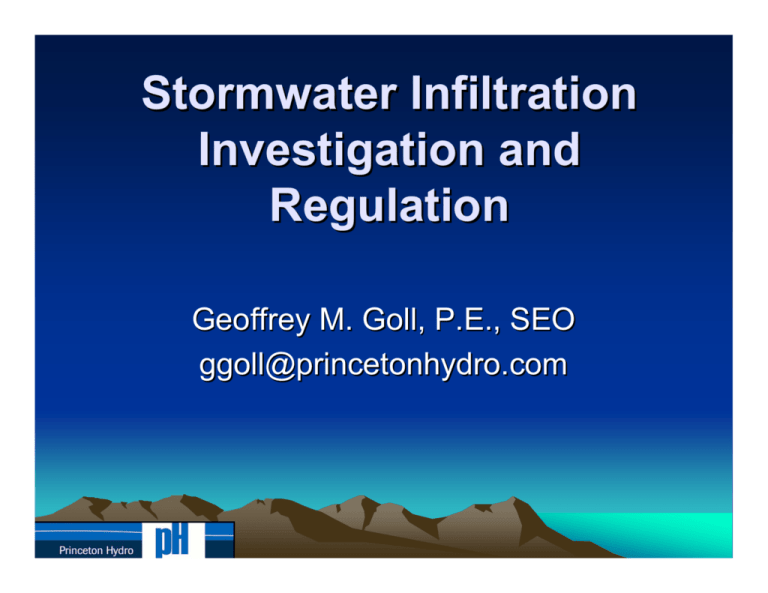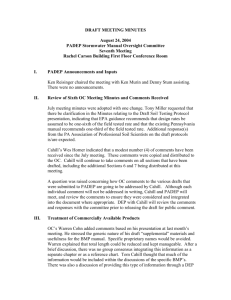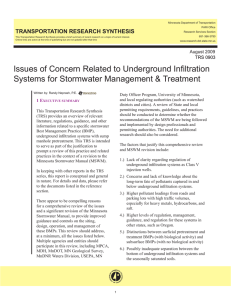Presentation - Villanova University
advertisement

Stormwater Infiltration Investigation and Regulation Geoffrey M. Goll, P.E., SEO ggoll@princetonhydro.com PADEP MANUAL IN FINAL DRAFT • Provides guidance on the final link for implementation to the PADEP Comprehensive Stormwater Management Policy. Act 167 Planning Program NPDES Construction Permits Comprehensive Stormwater Management Policy BMP Manual NPDES Phase II MS4s COMPREHENSIVE STORMWATER POLICY • “A uniform approach to post-construction stormwater management that emphasizes groundwater recharge through infiltration and discharge volume and rate control with the goal of replicating infiltration and runoff characteristics of the site prior to development.” BMP Recommendations • The BMP Manual recommends removing the difference in volume between the 2year storm, pre-development to postdevelopment or infiltrating the first 0.5 inches when 1.5 inches of rain are to be captured and removed from runoff. BMP Recommendations • The BMP manual emphasizes controlling runoff from a site using Low-Impact Development (LID) techniques to maintain pre-development conditions as closely as possible. • However, at some point infiltration will be required to meet the infiltration/recharge deficit caused by development and the creation of impervious surfaces. To Infiltrate One Must Understand the Underlying Soils and Geology • 35% of the state soils contain less than 40” of soil overlying bedrock[i]. • 61% of the State’s soils are characterized as Hydrologic Type C & D Soils[ii] • • [i] Pennsylvania Association of Soil Scientists, “Take and Interactive Quiz on Pennsylvania Soils!”, http://www.papss.org/PA%20soils%20quiz%20ques%202.htm\ [ii] PADEP BMP Manual To Infiltrate One Must Understand the Underlying Soils and Geology Central Michigan University (2004), “ESC/BIO 334-Soil Science, How a Soil Forms”, http://www.cst.cmich.edu/users/Franc1M/esc334/lectures/origin.htm To Infiltrate One Must Understand the Underlying Soils and Geology Source: http://courses.missouristate.edu/ejm893f/creative/glg110/groundwater.html To Infiltrate One Must Understand the Underlying Soils and Geology Source: http://courses.missouristate.edu/ejm893f/creative/glg110/groundwater.html To Infiltrate One Must Understand the Underlying Soils and Geology GROUNDWATER MOUNDING CAN REDUCE REQUIRED SEPARATION DISTANCES, FAIL A BASIN, AND CAUSE FLOODING TO ADJACENT STRUCTURES. Kaveh, Ph.D., Zamorodi, “Simplified Solutions for Groundwater Mounding Under Stormwater Infiltration Facilities “, Dewberry, Fairfax, VA, Figure 2. Recommended Testing in Addition or as an Alternate to the BMP Recommendations • Installation of Shallow Wells or Piezometers •In-situ Falling Head Permeability. •Slug Testing. • Open Pit Testing •Basin Flood Tests. •Pit Bail Testing. Recommended Testing in Addition or as an Alternate to the BMP Recommendations • In situations where groundwater mounding is a concern, more complicated testing and analysis is recommended: •Installation of Monitoring Wells, and observation wells. •Aquifer stress testing (pump tests). •Modeling mounding using techniques such as ModFlow™. Proposed Regulatory Incentives Need incentive to engineers, developers and governmental agencies to move away from “End-ofthe-Pipe” solutions to realistically meet objectives of the Comprehensive Stormwater Management Policy and intent of the BMP Manual. One idea: As infiltration techniques are proposed closer and closer to the runoff source, complex field testing and modeling techniques could be relaxed. Need Municipal Enforcement • Once construction is complete and the developer walks away, who will ensure on-lot infiltration techniques are maintained in perpetuity?????? Rain gardens, drywells, infiltration trenches, porous pavement, sandfilters, and bioretention, and infiltration basins. These are great ideas........................ .....if the property owner maintains them!!! Need Municipal Enforcement If the Township Maintains rights to these techniques, easement can get cumbersome and onerous. One idea comes from Act 537, the Sewage Facilities Act. Act 537, the Sewage Facilities Act •Act 537 requires permitting of each septic system; •A PADEP certified Sewage Enforcement Officer is responsible for enforcing the Act; •No easement or deeds necessary. Permits are kept on file at the Township, County and State; •Township via permit has right to enter property is there is suspicion that system is not being maintained. Who Should Review Designs and Enforce Functionality? Who Should Review Designs and Enforce Functionality? •Soil Scientist •Professional Geologist or Hydrogeologist •Geotechnical Engineer Above Professional would report Municipal Engineer or Directly to Municipality. Reimbursement Programs for Enforcement •Act 167 specifically provides for reimbursement of up to 75% of the costs for the preparation of stormwater management plans and actual administrative, enforcement and implementation costs and revisions to stormwater management plans required by the Act. •The plan also reimburses the fees required for special technical consultation concerning complex or unusual stormwater management issues. Thank you!








